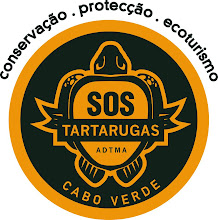 |
| The all female Maio team! |
Maio has really suffered as the forgotten island in terms of turtle conservation as, despite the City Hall's programme of monitoring & guarding turtles, there has never been a consistent and well coordinated project.
This year the City Hall, ACCC (a study on climate change) & Natura 2000 all patrolled and collected data but there was no overall coordination in order to ensure consistent methodology.
 |
| Joao, a guard during 2011 explains his work |
In the past few years the City Hall has paid guards from outlying villages to patrol the beaches and collect simple data (number of nests & tracks and number of turtles killed). The funds for this activity comes from the DGA (General Directorate of the Environment) and this has been supplemented with training and equipment from ourselves, Natura 2000, Biosfera I and others.
 |
| Turtle nesting beach on Maio |
The situation on Maio is critical, since it is believed to be the second largest nesting area in Cape Verde, but there is very little data available. The number of turtles being killed each year on the land and in the surrounding sea is unknown but believed to be very high and the amount of nests stolen is probably the highest of any of the islands here.
To see what can be done to improve the situation, SOS Tartarugas arranged a visit which included a representative of the US Fish & Wildlife Service, a very important funder of turtle conservation in Cabo Verde. During meetings with the City Hall and the Foundation for Biodiversity in Maio, it seems as if an overall management plan can be developed and implemented in 2012.
 |
| The salina on Maio, a very important biodiversity site |
The Foundation is a very important partner for SOS since they are already well integrated in the community in Maio and will be able to coordinate and communicate with all the interested groups and individuals.
Not only will this brand new foundation work in turtle protection, but they are already deeply involved in the preservation of habitat and other species on the island. One of the most important projects is research & conservation of the Kentish Plover Charadrius alexandrinus. (For more information about this important work follow this link).
 |
| The Sogei resort with the sea on the left & salina on the right |
This small bird nests on the ground following the seasonal rains and the salina on Maio is very important habitat for them. Unfortunately for the environment, development has reached Maio and the residential/hotel development is situated in a small strip of beach between the sea on the left and the salina on the right. The construction is going very slowly because few people have bought properties, however the impact on the birds and other wildlife has already been very serious.
 |
| The little scrape of sand that is a nest |
The Kentish Plover nests on the ground, making a tiny scrape in the sand and is extremely vulnerable to predation. This photo shows the last remaining nest which on our visit was found to be predated.
The foundation has many difficult hurdles in their path, with not only these two species to protect, but many more and they face the prospect of the same extensive loss of habitat as here on Sal.










